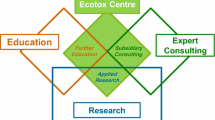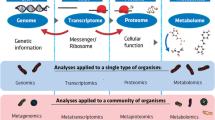Abstract
A Natural Environment Research Council (NERC) funded Knowledge Transfer (KT) workshop was held in the United Kingdom (UK) to identify the needs and opportunities in the application of molecular biology and ‘omics’ techniques to environmental monitoring and risk assessment. Attendees highlighted a lack of effective communication between end-users and researchers as well as difficulties with data interpretation as reasons behind the slow uptake of molecular biology and omics techniques. A number of promising areas in which new techniques could be implemented at a practical level in the very near future were identified, thereby raising the profile of these recent technologies and providing vital proof of concept work. Molecular taxonomy, bacterial source tracking and pre-screening of chemicals for potential toxicities were all viewed as areas in which omics and molecular techniques could have immediate value, with the aim of reducing cost, increasing efficiency and providing more comprehensive data of improved quality.
Similar content being viewed by others
References
Ankley GT, Daston GP, Degitz SJ, Denslow ND, Hoke RA, Kennedy SW, Miracle AL, Perkins EJ, Snape J, Tillitt DE, Tyler CR, Versteeg D (2006): Toxicogenomics in Regulatory Ecotoxicology. Environ Sci Technol 40, 4055–4065
Centre for Evidence-Based Conservation. (2007): CEBC Systematic Reviews. Available from: 〈http://www.aebc.bham.ac.uk/systematicreviews.htm〉 (cited 27/03/07)
Côté IM, Gill JA, Gardner TA, Watkinson AR (2005): Measuring coral reef decline through meta-analyses. Phl Trans Royal Soc Biol Sci 360, 385–395
Ellinger-Ziegelbauer H, Stuart B, Wahle B, Bonann W, Ahr HJ (2005): Comparison of the expression profiles induced by genotoxic and nongenotoxic carcinogens in rat liver. Mutation Research 575, 61–84
Hines A, Oladiran GS, Bignell JP, Stentiford GD, Viant MR (2007): Direct sampling of organisms from the field and knowledge of their phenotype: Key recommendations for environmental metabolomics. Environ Sci Technol 41, 3375–3381
Lindon JC, Keun HC, Ebbels TMD, Pearce JMT, Holmes E, Nicholson JK (2005): The Consortium for Metabonomic Toxicology (COMET): aims, activities and achievements. Pharmacogenomics 6, 691–699
Moggs JG, Tinwell H, Spurway T, Chang H.S, Pate I, Lim FL, Moore DJ, Soames A, Stuckey R, Currie R, Zhu T, Kimber I, Ashby J, Orphanides G (2004): Phenotypic anchoring of gene expression changes during estrogen-induced uterine growth. Environ. Health Perspect 112, 1589–606
Soetaert A, van der Ven K, Moens LN, Vandenbrouck T, van Remortel P, De Coen WM (2007): Daphnia magna and ecotoxicogenomics: Gene expression profiles of the anti-ecdysteroidal fungicide fenarimol using energy-, molting-and life stage-related cDNA libraries. Chemosphere 67, 60–71
Sutherland WJ, Armstrong-Brown S, Armsworth PR, Brereton T, Brickland J, Campbell CD, Chamberlain DE, Cooke AI, Dulvy NK, Dusic NR, Fitton M, Freckleton RP, Godfray HCJ, Grout N, Harvey HJ, Hedley C, Hopkins JJ, Kift NB, Kirby J, Kunin WE, MacDonald DW, Marker B, Naura M, Neale AR, Oliver T, Osborn D, Pullin AS, Shardlow MEA, Showler DA, Smith PL, Smithers RJ, Solandt J, Spencer J, Spray CJ, Thomas CD, Thompson J, Webb SE, Yalden DW, Watkinson AR (2006): The identification of 100 ecological questions of high policy relevance in the UK. J Applied Ecology 43, 617–627
Viant MR, Bundy JG, Pincetich CA, de Ropp JS, Tjeerdema RS (2005): NMR-derived developmental metabolic trajectories: An approach for visualizing the toxic actions of trichloroethylene during embryogenesis. Metabolomics 1, 149–158
Viant MR, Pincetich CA, Hinton DE, Tjeerdema RS (2006): Toxic actions of dinoseb in medaka (Oryzias latipes) embryos as determined by in vivo 31P NMR, HPLC-UV and 1H NMR metabolomics. Aquatic Toxicology 76, 329–342
Waring JF, Jolly RA, Ciurlionis R, Lum PY, Praestgaard JT, Morfitt DC, Buratto B, Roberts C, Schadt E, Ulrich RG (2001): Clustering of hepatotoxins based on mechanism of toxicity using gene expression profiles. Toxicol Applied Pharmacol 175, 28–42
Williams TD, Diab AM, George SG, Godfrey RE, Sabine V, Conesa A, Minchin SD, Watts PC, Chipman JK, (2006): Development of the GENIPOL European flounder (Platichthys flesus) microarray and determination of temporal transcriptional responses to cadmium at low dose. Environ Sci Technol 40, 6479–88
OECD (2005): Report of the OECD/IPCS Workshop on Toxicogenomics. OECD Environmental Health and Safety Publications, Series on Testing and Assessment No. 50, April 2005 〈http://appli1.oecd.org/olis/2005doc.nsf/43bb6130e5e86e5fc12569fa005d004c/d49a5f7fdfa04f97c1256ff200379c99/$FILE/JT00183336.PDF〉
Author information
Authors and Affiliations
Corresponding author
Rights and permissions
About this article
Cite this article
Blunt, R.E., Walsh, K.A., Ashton, D.K. et al. Knowledge transfer initiative between molecular biologists and environmental researchers and regulators. Env Sci Poll Res Int 14, 293–296 (2007). https://doi.org/10.1065/espr2007.06.431
Published:
Issue Date:
DOI: https://doi.org/10.1065/espr2007.06.431




